With the coronavirus outbreak having spread to the White House, Americans are now almost equally divided on the question of whether the outbreak has been exaggerated or underplayed. And after trending downward for several months, the percentage of Americans very closely following news about the coronavirus outbreak has remained steady.
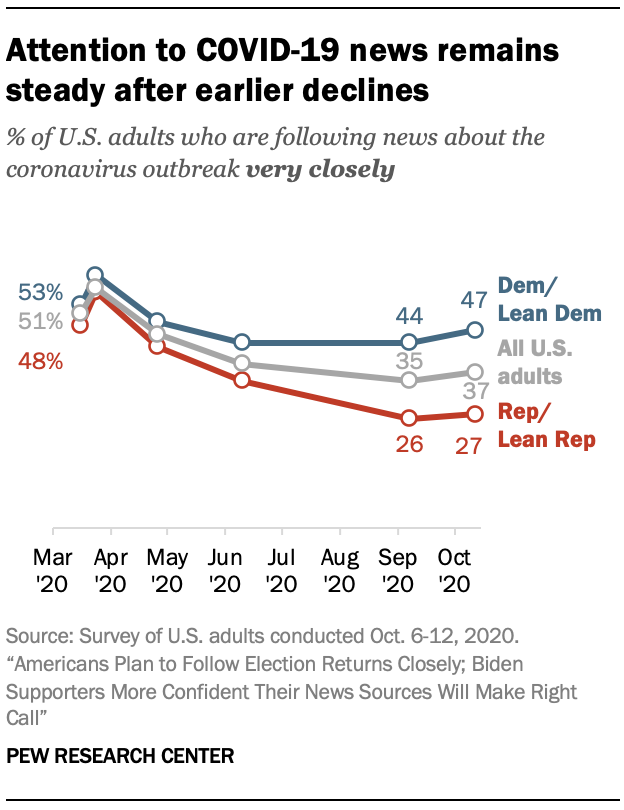
Among all U.S. adults, 37% say they are very closely following coronavirus news, about on par with the 35% who said they were doing so in early September. The new survey was conducted after news of President Donald Trump and the first lady testing positive broke on Oct. 2, with news of other administration officials testing positive becoming public within days of Trump’s diagnosis.
These findings show at least a pause to a steady trend of diminishing interest in coronavirus news over time. The portion of Americans very closely following coronavirus news fell from 57% at the outset of the pandemic in the U.S. in late March to 46% in late April, 39% in early June, and 35% in early September before registering most recently at 37%.
The substantial partisan gap in attention to coronavirus news that emerged in recent months remains. Nearly half of Democrats and those who lean Democratic (47%) are paying very close attention to coronavirus news, compared with about three-in-ten Republicans and Republican leaners (27%).
Public now almost equally divided on question of whether outbreak has been exaggerated or underplayed
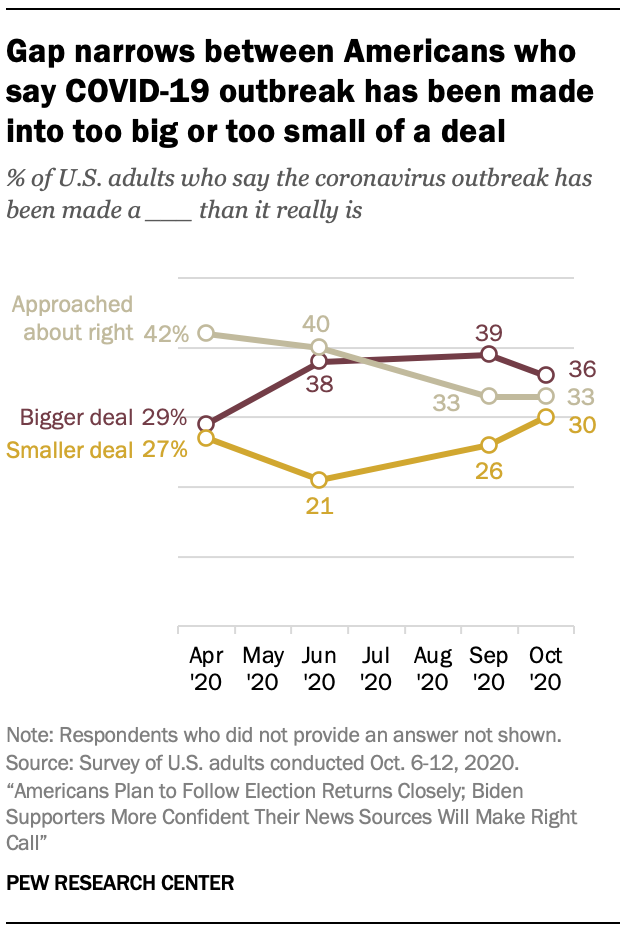
The public’s assessment of whether the coronavirus outbreak has been exaggerated or underplayed also shifted slightly after the White House infection. Overall, 36% of U.S. adults say the outbreak has been made into a bigger deal than it really is, while 30% say it has been made into a smaller deal than it really is and 33% say it has been approached about right. The 6 percentage point gap between those who say it has been exaggerated and those who say it has been underplayed is down from a gap of 13 percentage points in September (39% vs. 26%). And it is the narrowest gap since late April, when 29% said the outbreak was being made into a bigger deal than it really was and 27% said it had been underplayed.
In this most recent survey, there is major partisan disagreement on this subject, with 63% of Republicans saying the outbreak has been overblown, compared with 14% of Democrats who share this view. Meanwhile, 46% of Democrats say the pandemic has been underplayed; just 12% of Republicans say the same. These partisan divides are nearly the same as they were just prior to Trump’s infection; neither party’s responses changed substantially since September.
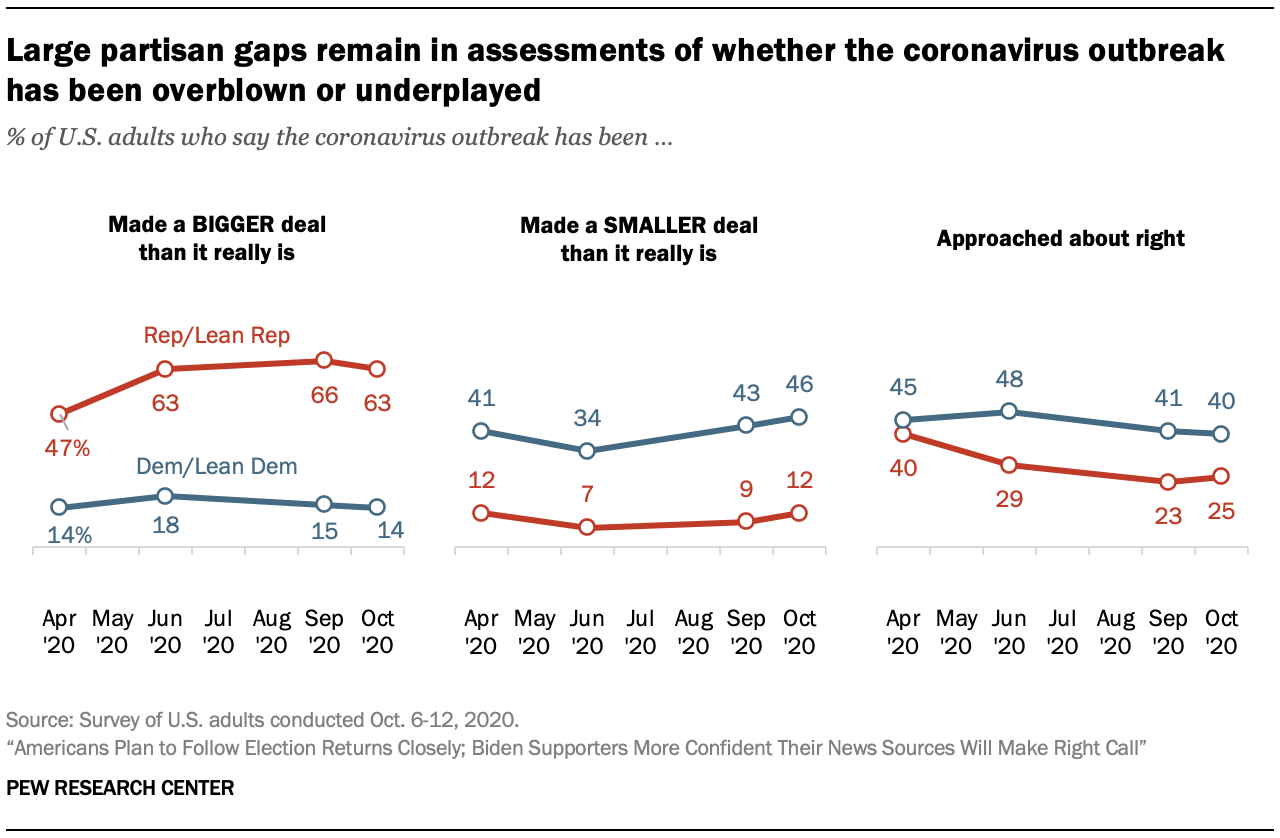
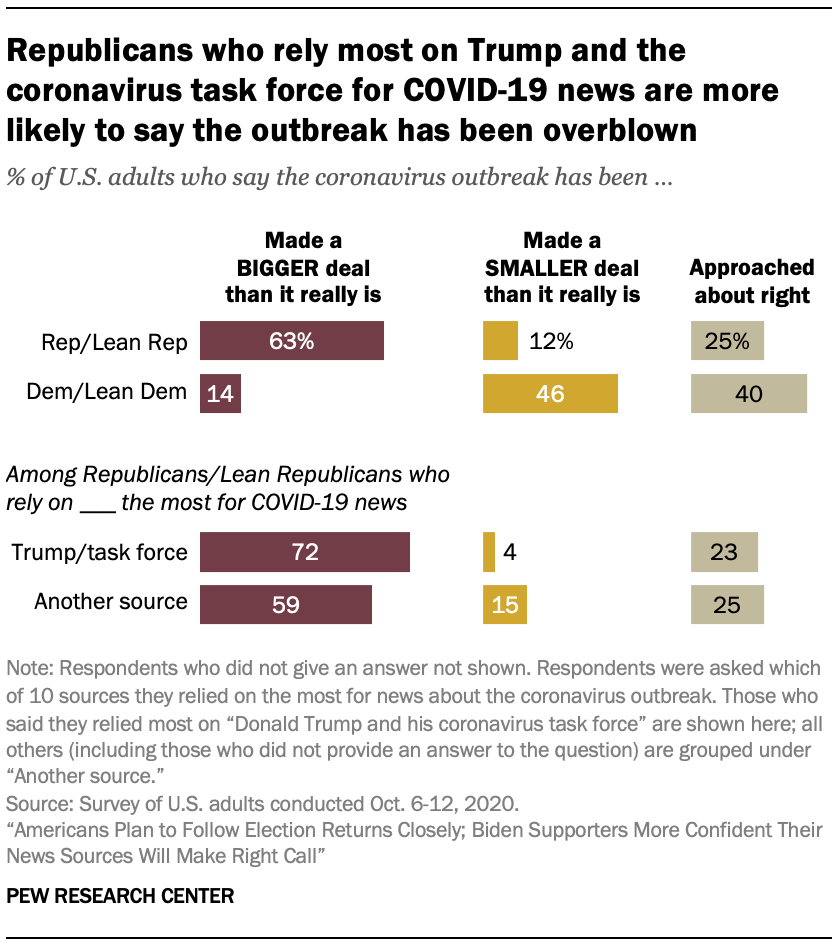
Among Republicans, another group whose sentiment did not shift in any significant way is the group that relies most on Trump and his task force for news about the coronavirus pandemic. (Respondents had earlier identified which of 10 types of sources they rely on most for COVID-19 news, including Trump and his task force.)
This group of Republicans who rely most on Trump and his task force have consistently been more likely than other Republicans to say that the outbreak has been exaggerated, and this continues to be true following Trump’s infection. Fully 72% of this group say that the outbreak has been overblown, compared with 59% of other Republicans. (In September, those percentages were 75% and 63%, respectively.) And just 4% of Republicans who rely on the White House most for COVID-19 news say that the outbreak has been underplayed, compared with 15% of other Republicans.
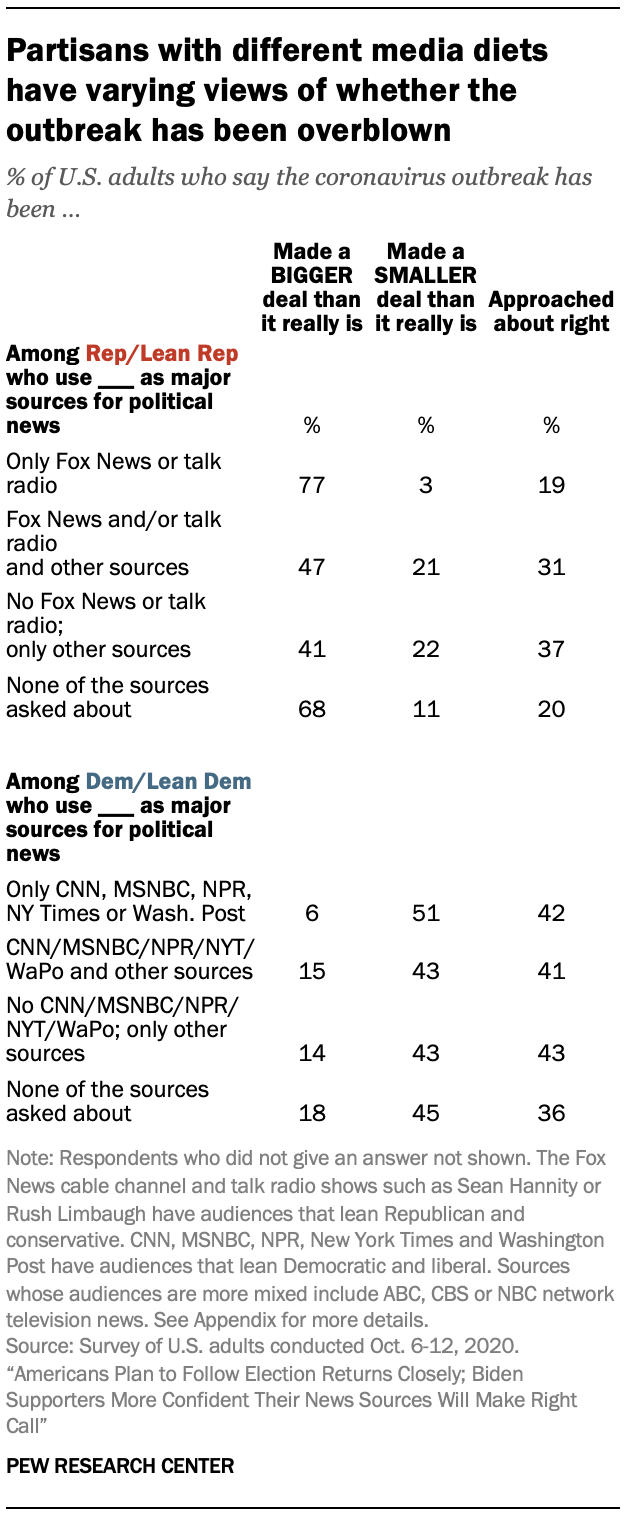
Similar to findings from early September, differences within party also exist based on where partisans get their news. Republicans whose only major sources for political and election news are Fox News and talk radio were much more likely than other Republicans to say that the pandemic has been overblown – 77% say this, while 3% of this group say it has been made a smaller deal than it really is. But for Republicans whose major sources included a mix of Fox or talk radio along with other outlets, 47% say the outbreak has been made a bigger deal than it really is, with 21% saying it has been underplayed.
Among Democrats, the group only turning to outlets asked about with left-leaning audiences as major sources – CNN, MSNBC, NPR, The New York Times or The Washington Post – were more likely than other Democrats to say that the pandemic had been underplayed (51%, vs. 43% of Democrats whose major sources included a mix of those with left-leaning audiences and other sources asked about).
These patterns do not necessarily prove that partisans are taking their cues directly from their news sources. Other factors beyond media diet may impact people’s assessments of how the U.S. has reacted to the outbreak. And the relationship can go in either direction: People can either pick their media sources to fit their existing political views, or have their views shaped by those sources (or both at the same time). Still, the data shows a clear connection between news diet and views on the pandemic.
Large differences on how well U.S. controlled the outbreak based on party and news diet
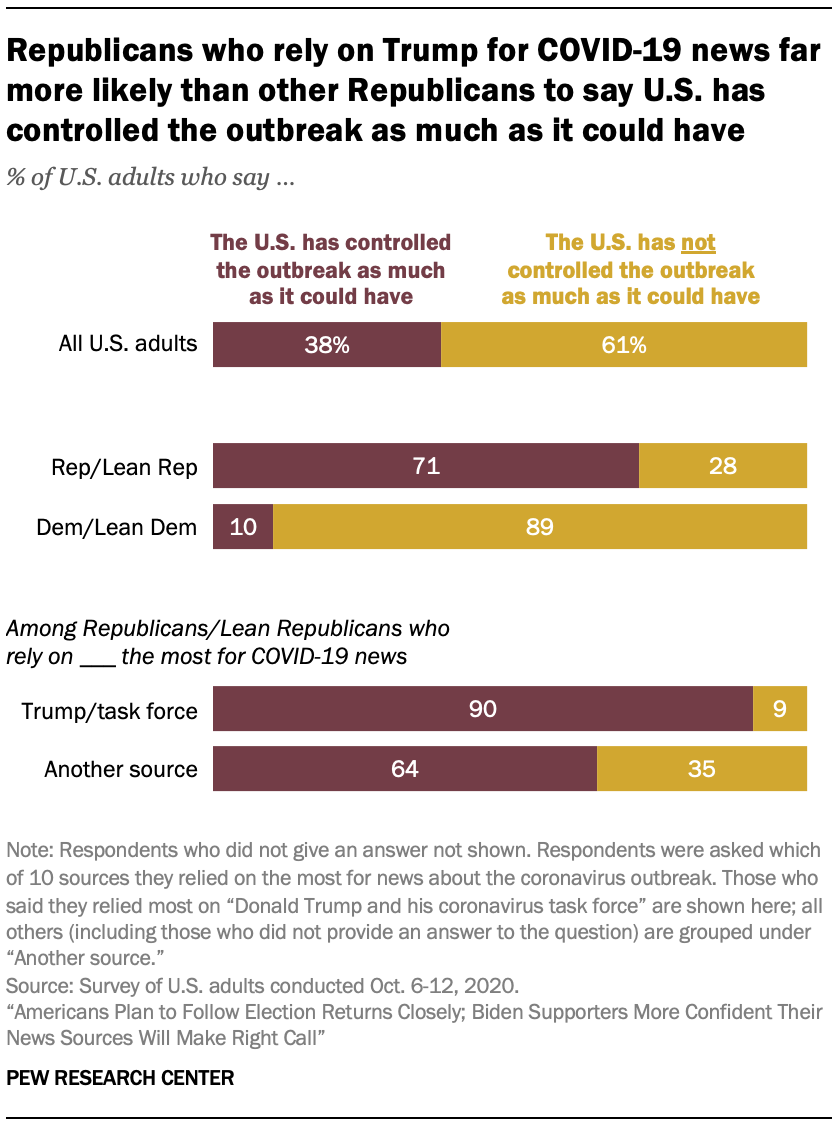
When asked how well the U.S. has controlled the coronavirus outbreak, 61% of all Americans now say the country has not controlled it as much as it could have while 38% say it has – numbers that are basically unmoved since September.
The large partisan difference on this question also remains. The October survey reveals that about seven-in-ten Republicans (71%) say the country has controlled the coronavirus as much as it could, and 28% say it has not. On the Democratic side, just 10% say the outbreak has been controlled as much as possible, compared with about nine times that many who say it has not been (89%).
Among Republicans, there are differences between those who turn to the White House for information and those who don’t. Nine-in-ten who rely most on Trump and the task force for coronavirus news say the country has controlled the outbreak as much as it could, compared with about two-thirds (64%) of Republicans who don’t rely on Trump and the task force.
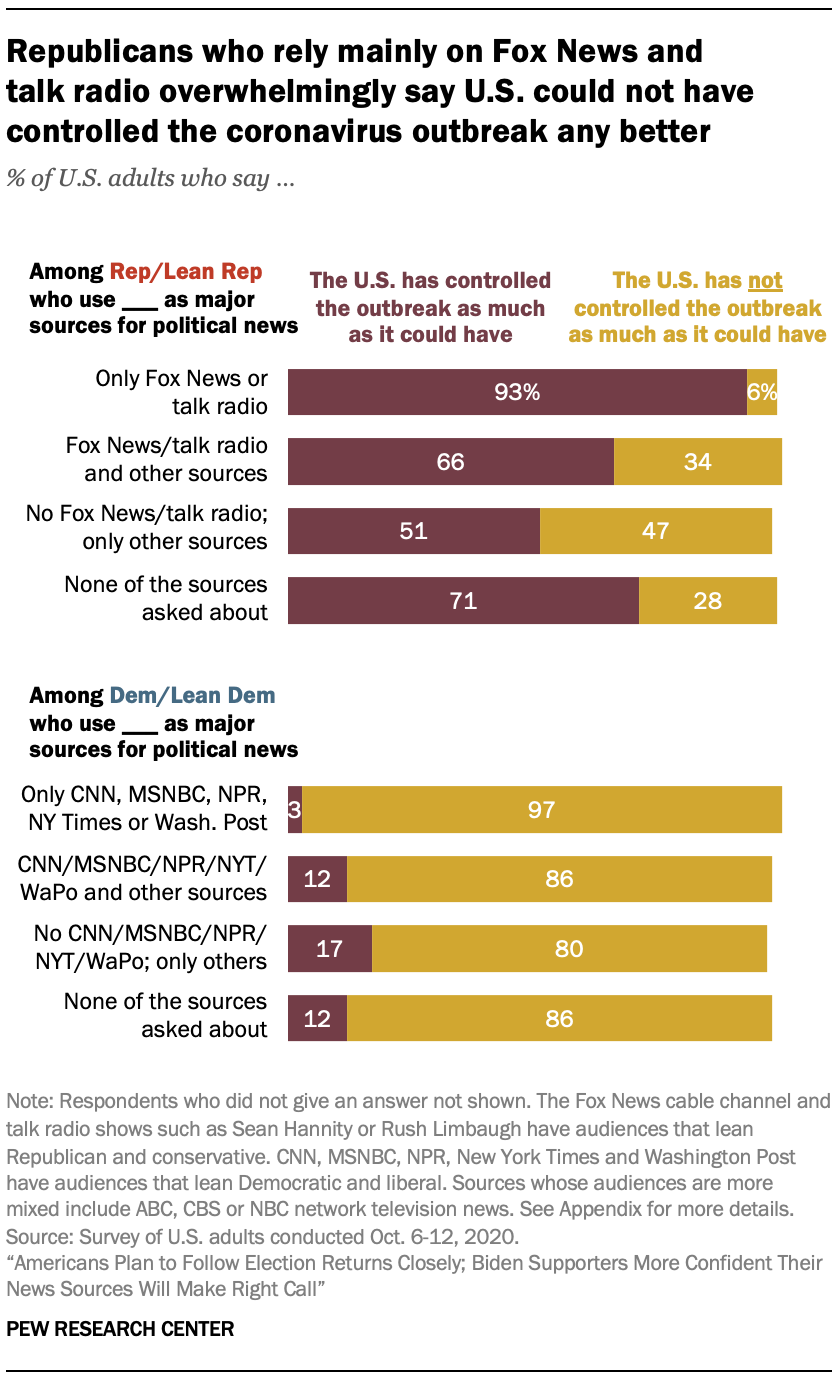
Within the Republican Party, as in September, there are also significantly different responses based on media diet. Republicans whose major sources for political and election news only include Fox News and/or talk radio are much more likely to say the pandemic has been controlled as much as possible (93%) than those with a mix of sources (66%) and those who name some major sources, but not Fox News or talk radio (51%). The differences among Democrats who choose different media diets are much smaller.
These partisan differences over how the U.S. has controlled the outbreak, as well as the differences based on information sources within parties, have remained relatively steady from September to October.
Most know that about 200,000 have died from COVID-19 in the U.S.; those closely following coronavirus news far more likely to know this
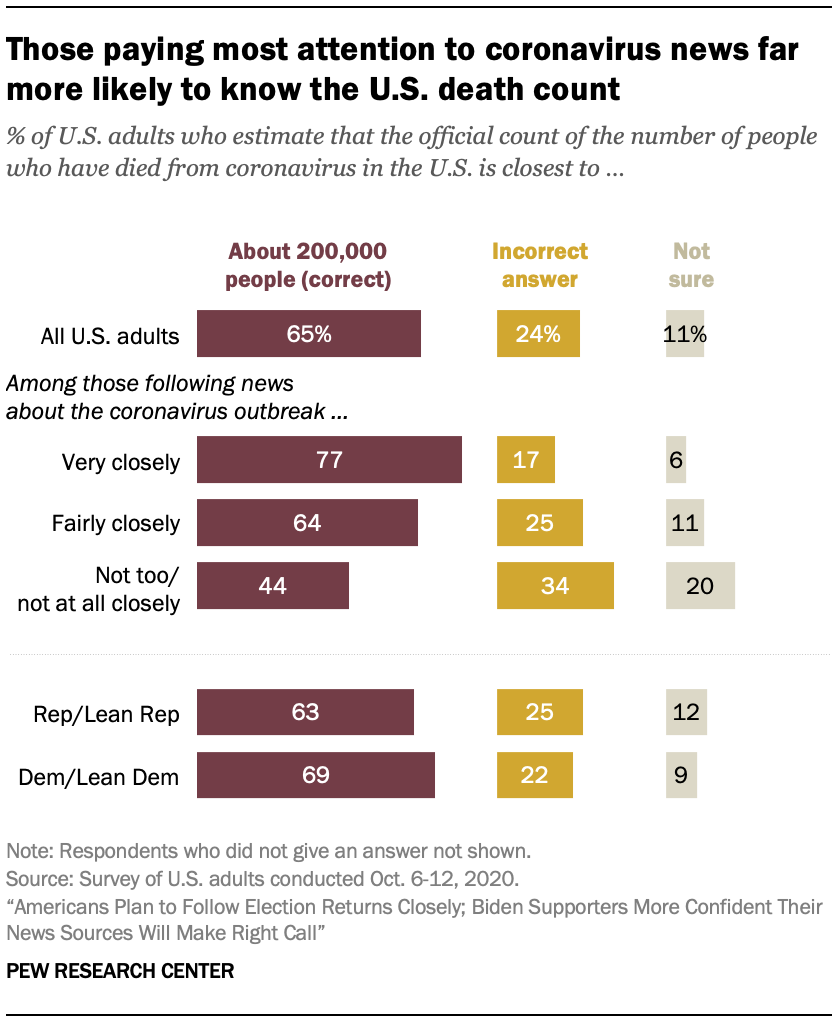
Among all Americans, 65% correctly say that about 200,000 people have thus far lost their lives to the virus in the U.S., choosing from options ranging from 50,000 to 500,000. Another 11% say they are not sure. No other choice generated more than a 7% response.
The partisan gaps seen in other questions do not appear here – majorities of both parties respond correctly, with 69% of Democrats and those who lean Democratic choosing the correct answer along with 63% of Republicans and those who lean Republican.
There is a much larger difference depending on how closely respondents said they are following news about the outbreak. Among those following coronavirus news “very closely,” about three-quarters (77%) correctly responded to the question about the number of deaths in the U.S. That drops to about two-thirds (64%) of those who say they are following “fairly closely,” and under half (44%) of those who said they are following the outbreak “not too closely” or “not at all closely.”
The group following coronavirus news least closely (which makes up 20% of Americans) are also the most likely group to give neither a correct nor an incorrect answer, but to say that they weren’t sure what the answer was (20% said this). Those following coronavirus news more closely were less likely to say this (6% of those following very closely and 11% of those following fairly closely).




